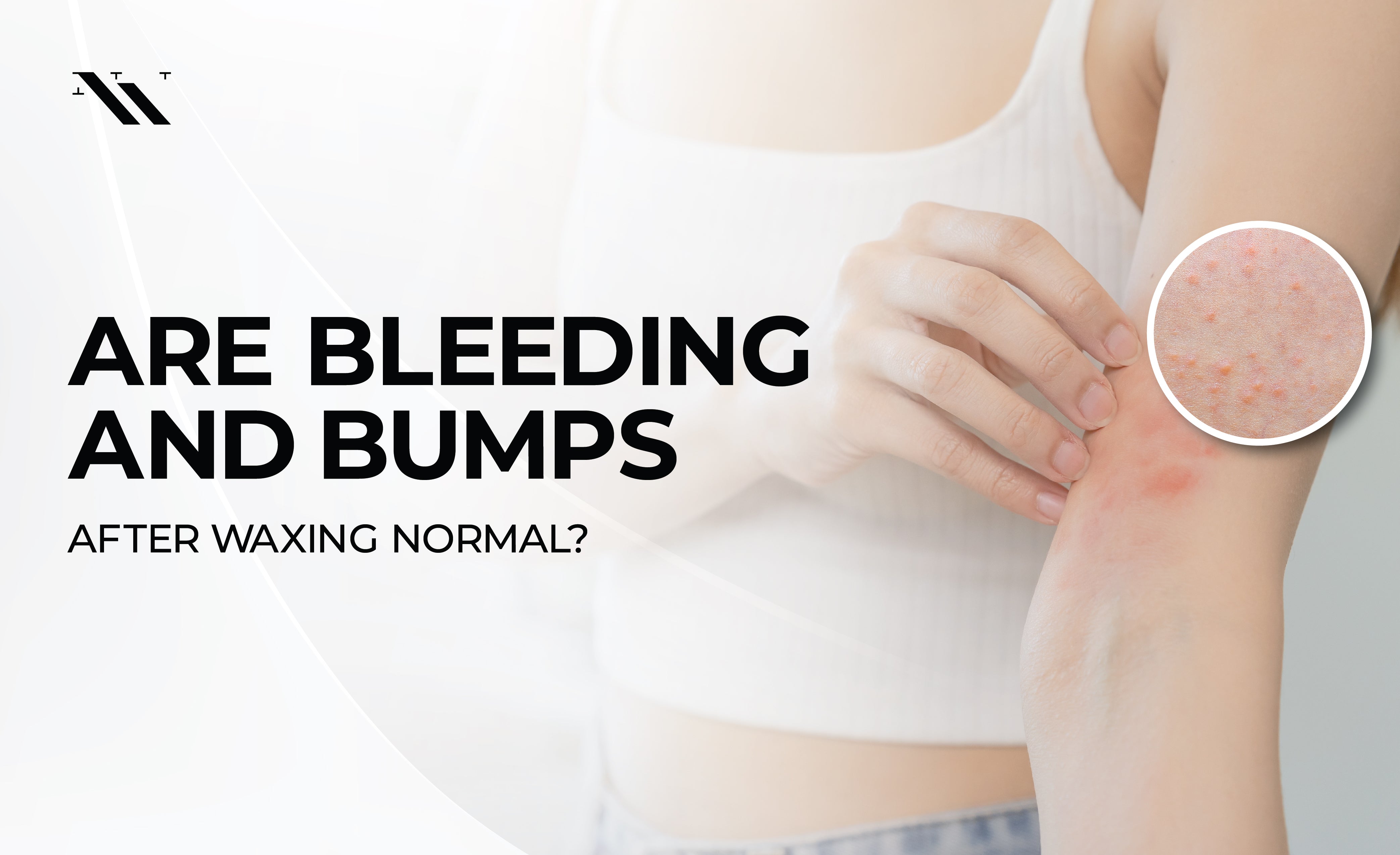Your Cart is Empty
Are Bleeding and Bumps After Waxing Normal?
by Kirstyn Porter August 26, 2023 7 min read
0 Comments
If you've experienced bleeding and bumps after waxing, don’t worry! It’s completely normal and luckily we’ve got the tips and precautions to take in order to prevent them in the future.
Table of Contents
- Is It Normal to Get Bumps After Waxing
- How Long Does It Take for Waxing Bumps to Go Away?
- Why Do My Pores Bleed When I Wax?
- Bumps After Waxing Face
- Can A Brazilian Wax Leave Bumps Or Cause Bleeding?
- Tips to Prevent and Treat Reactions Caused By Waxing
- Which Wax to Use to Prevent Bleeding & Bumps
- What to Do Immediately After Waxing?
- Summary
Is it Normal to Get Bumps After Waxing?
Yes! Waxing is a form of superficial “trauma” on the skin. When hair is forcefully removed from the root, it causes stress to the surrounding skin. It is very likely for most people to develop mild bumps and inflammation after a wax, especially if they are new to waxing!

Folliculitisis one of the most common side effects of waxing and is nothing to be alarmed with.
Folliculitis after waxing looks similar to a rash, with the appearance of pimples and slight bumpiness. This usually happens if your pores get clogged after waxing. Folliculitis normally goes away on its own in a few days.

Ingrown Hairs are also very common, and are a type of folliculitis. Ingrown hairs are naturally more common for those with curly or coarse hair, but can also occur when the proper wax aftercare isn’t followed.
Instead of normal growth outwards, an ingrown hair grows back into the skin creating a small bump on the skin. Ingrown hairs have the potential to show up in up to 1 week after a waxing procedure.
If you have white or fluid-bumps lasting several days, it is possible that the folliculitis or ingrown hair may be the result of a mild infection.
Read More: Ingrown Hairs & Waxing

Contact Dermatitisis common for those with sensitive skin. This condition often occurs when you are prone to some kind of allergic reaction. This reaction usually happens if there is a sensitivity to an ingredient in the wax, or even the products used on the area after a wax.
The bumps that grow afterward can be irritating and itchy, with possible stinging sensation, and can also cause swelling and peeling in certain cases. It is not life-threatening or contagious! If this happens, you may need to research the ingredients in your products to see if you have any sensitivities or allergies to anything.
How Long Does It Take For Waxing Bumps to Go Away?
Depending on the type of bump and the level of severity, waxing bumps can disappear anywhere between 24-hours post wax or up to a week.
Folliculitis is the most common reaction and also the least alarming. Bumps from folliculitis usually subside within 24-48 hours post wax.
Ingrown hairs are trickier and will most likely need to be manually extracted in order to properly heal. If you see pus forming, or an ingrown hair getting infected (which could happen even a week after waxing) you should get it checked by a dermatologist as the severity of the infection will determine how long recovery will be.

Why Do My Pores Bleed When I Wax?
Pore bleeding, or “pinpoint bleeding” is a common result of waxing, and is actually a sign that the hair was removed successfully from the root.
Each hair follicle on our body is connected to a blood vessel that supplies blood to the hair for it to grow. When hair is removed, blood may follow the hair out resulting in visible “pricks” of blood on the surface of the skin. Pinpoint bleeding should not be alarming and is, in fact, a great thing to see! This means the hair was fully removed from the root, and not broken at the surface.
Bleeding after waxing is normal in first-time/new waxers and is more likely to happen in sensitive, tight pore areas like the underarms or bikini and Brazilian area. The bleeding usually subsides on the same day as the wax.
Some factors can increase how easily your pores bleed, such as blood thinners like pain relievers (aspirin) and certain prescription medications.
If you are seeing an esthetician for a wax service, always let them know what medications you are taking so they can be aware that you might be prone to bleeding.
If you are thinking of starting an at-home waxing regimen, it is also best to speak with your dermatologist beforehand, as certain treatments like Accutane or Retinol make the skin extremely sensitive and do not pair well with waxing.
Bumps After Waxing Face
Noticing bumps after a facial wax is very common! The skin on the face is particularly sensitive and since many people use active ingredients on the skin, it’s more prone to irritation.
Even if you stop using actives before your wax (something you should always do!), there’s still a higher risk of seeing bumps than other places on the body.
If you notice bumps on your face after waxing, never pick at them or try to pop them. Instead, use a cold compress and gentle cleanser 2x a day.

How Do You Get Rid of Bumps On the Face After Waxing?
If you weren't able to prevent bumps after facial waxing, the best things to do is to cleanse the skin with soap and warm water or by using a cold compress.
Doing this help reduce irritation and the appearance of bumps after a wax.

Can A Brazilian Wax Leave Bumps Or Cause Bleeding?
ABrazilian wax is one of the more common areas where bleeding can occur since it's a more sensitive area of the body. Again - it is nothing to be alarmed by! If you are pinpoint bleeding after a Brazilian wax, that means the wax was successful and the hair was fully removed from the root! The bleeding does subside in a few hours, and you’re good to go!
Bumps are a natural reaction to hair being forcefully removed from the root. If bumps show immediately after waxing, you can trust that it’s just an initial reaction and that it should subside within the same day. If the bumps linger, it could be irritation due to improper wax aftercare.
Also Read: Bikini & Brazilian Waxing Tips
Tips to Prevent and Treat Reactions Caused By Waxing
If you’re experiencing bumps or ahistamine reaction after waxing, it is usually best to leave it alone to heal on its own. There are a few things you can do, however, to try to reduce swelling and inflammation.
- Wear loose clothing - Tight fabrics can increase irritation on already sensitive skin through rubbing or perspiration.
- Apply a cool compress - Whether it's an ice pack or a washcloth saturated in cold water, you can apply the compress to the affected area for up to 20 minutes.
- Avoid picking or popping- Messing with the area will not only damage your skin, but it can introduce bacteria to the area and increase your risk of infection.
- Apply Witch hazel-Witch hazel has astringent and antiseptic properties, which can help calm the skin and can help prevent the reaction from worsening. Soak a cotton pad in alcohol-free witch hazel and apply to the affected area up to three times daily.
- Apply Hydrocortisone cream- Hydrocortisone can be applied after waxing and is used to treat redness, swelling, itching, and discomfort.
- Use Tea Tree Oil - Oil is heavy, and more likely to clog pores especially in the first day or two after waxing, so this is best used later on for lingering or late-forming irritation. For an immediate alternative, you can also use a gel containing tea tree oil since gels are much lighter and do not clog pores.

The best way to prevent reactions to waxing is by following a proper pre and post wax routine. Exfoliation is one of the primary ways to avoid ingrown hairs, and it is also a great way to nourish your skin! Exfoliation helps to prevent the buildup of dead skin cells and other debris on the skin that can trap hair underneath (ingrowns) or lead to infection. Exfoliation with a mild scrub or exfoliating cloth every other day, at a minimum, will help ensure your skin is as healthy as possible!
Exfoliation is also recommended before a wax to prepare the skin for an easier hair removal. Gentle exfoliation a day or two before your wax (not the day of!) can help remove dead skin on the surface so the wax can be more effective.
Dry, brittle skin can cause the wax to crack and break - leading to an unsuccessful and potentially more painful hair removal. By buffing away the dry skin on the surface, the wax will adhere more to the hair instead of the skin.
Which Wax to Use to Prevent Bleeding & Bumps
Nova Wax is an all-in one hard wax made to be extra gentle on all skin types. This premium wax was created to the specifications of master esthetician, Liz Lugo, by the brilliant chemists behind Starpil Wax.
By following best practices such as using pre/post waxing care during your waxing services, you can further reduce your chances of the skin being irritated.
What to Do Immediately After Waxing?
The first 48 hours post-waxing are crucial to your recovery!
The area you waxed is extra sensitive, so you need to protect it as best as you can.
Immediately after a wax, you should wear loose clothing and avoid any activities that potentially irritate your skin - such as exfoliating, sweating, sun exposure, saunas, and steamy, hot baths or showers. Take it easy and let your skin recover! It is also best to avoid any deodorant, heavy lotions or creams, makeup, or any topical that can clog your pores.
After the 48 hour “waiting period,” you can begin your regular exfoliation about two or three times a week to keep your skin smooth and help you avoid the ingrown hairs and bumps that can pop up once the hair begins to grow again. Use a moisturizing body wash or lotion after your shower to keep your skin hydrated and plump!
Summary
What’s beauty without a little work, right? Bumps and bleeding after a wax are just a small side effect, but are totally worth it for the smooth, long-lasting results! Remember, bleeding after a wax is actually a GREAT sign and bumps are a completely normal reaction.
With the proper preparation and post-care, you can ensure your side effects are minimal! In the case that something worse does happen, you know the signs to look for and how to treat it.





